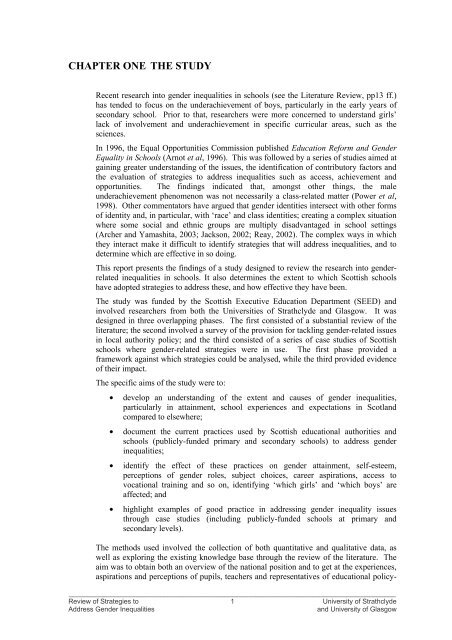Review of Strategies to Address Gender Inequalities in Scottish ...
Review of Strategies to Address Gender Inequalities in Scottish ...
Review of Strategies to Address Gender Inequalities in Scottish ...
Create successful ePaper yourself
Turn your PDF publications into a flip-book with our unique Google optimized e-Paper software.
CHAPTER ONE THE STUDYRecent research <strong>in</strong><strong>to</strong> gender <strong>in</strong>equalities <strong>in</strong> schools (see the Literature <strong>Review</strong>, pp13 ff.)has tended <strong>to</strong> focus on the underachievement <strong>of</strong> boys, particularly <strong>in</strong> the early years <strong>of</strong>secondary school. Prior <strong>to</strong> that, researchers were more concerned <strong>to</strong> understand girls’lack <strong>of</strong> <strong>in</strong>volvement and underachievement <strong>in</strong> specific curricular areas, such as thesciences.In 1996, the Equal Opportunities Commission published Education Reform and <strong>Gender</strong>Equality <strong>in</strong> Schools (Arnot et al, 1996). This was followed by a series <strong>of</strong> studies aimed atga<strong>in</strong><strong>in</strong>g greater understand<strong>in</strong>g <strong>of</strong> the issues, the identification <strong>of</strong> contribu<strong>to</strong>ry fac<strong>to</strong>rs andthe evaluation <strong>of</strong> strategies <strong>to</strong> address <strong>in</strong>equalities such as access, achievement andopportunities. The f<strong>in</strong>d<strong>in</strong>gs <strong>in</strong>dicated that, amongst other th<strong>in</strong>gs, the maleunderachievement phenomenon was not necessarily a class-related matter (Power et al,1998). Other commenta<strong>to</strong>rs have argued that gender identities <strong>in</strong>tersect with other forms<strong>of</strong> identity and, <strong>in</strong> particular, with ‘race’ and class identities; creat<strong>in</strong>g a complex situationwhere some social and ethnic groups are multiply disadvantaged <strong>in</strong> school sett<strong>in</strong>gs(Archer and Yamashita, 2003; Jackson, 2002; Reay, 2002). The complex ways <strong>in</strong> whichthey <strong>in</strong>teract make it difficult <strong>to</strong> identify strategies that will address <strong>in</strong>equalities, and <strong>to</strong>determ<strong>in</strong>e which are effective <strong>in</strong> so do<strong>in</strong>g.This report presents the f<strong>in</strong>d<strong>in</strong>gs <strong>of</strong> a study designed <strong>to</strong> review the research <strong>in</strong><strong>to</strong> genderrelated<strong>in</strong>equalities <strong>in</strong> schools. It also determ<strong>in</strong>es the extent <strong>to</strong> which <strong>Scottish</strong> schoolshave adopted strategies <strong>to</strong> address these, and how effective they have been.The study was funded by the <strong>Scottish</strong> Executive Education Department (SEED) and<strong>in</strong>volved researchers from both the Universities <strong>of</strong> Strathclyde and Glasgow. It wasdesigned <strong>in</strong> three overlapp<strong>in</strong>g phases. The first consisted <strong>of</strong> a substantial review <strong>of</strong> theliterature; the second <strong>in</strong>volved a survey <strong>of</strong> the provision for tackl<strong>in</strong>g gender-related issues<strong>in</strong> local authority policy; and the third consisted <strong>of</strong> a series <strong>of</strong> case studies <strong>of</strong> <strong>Scottish</strong>schools where gender-related strategies were <strong>in</strong> use. The first phase provided aframework aga<strong>in</strong>st which strategies could be analysed, while the third provided evidence<strong>of</strong> their impact.The specific aims <strong>of</strong> the study were <strong>to</strong>:• develop an understand<strong>in</strong>g <strong>of</strong> the extent and causes <strong>of</strong> gender <strong>in</strong>equalities,particularly <strong>in</strong> atta<strong>in</strong>ment, school experiences and expectations <strong>in</strong> Scotlandcompared <strong>to</strong> elsewhere;• document the current practices used by <strong>Scottish</strong> educational authorities andschools (publicly-funded primary and secondary schools) <strong>to</strong> address gender<strong>in</strong>equalities;• identify the effect <strong>of</strong> these practices on gender atta<strong>in</strong>ment, self-esteem,perceptions <strong>of</strong> gender roles, subject choices, career aspirations, access <strong>to</strong>vocational tra<strong>in</strong><strong>in</strong>g and so on, identify<strong>in</strong>g ‘which girls’ and ‘which boys’ areaffected; and• highlight examples <strong>of</strong> good practice <strong>in</strong> address<strong>in</strong>g gender <strong>in</strong>equality issuesthrough case studies (<strong>in</strong>clud<strong>in</strong>g publicly-funded schools at primary andsecondary levels).The methods used <strong>in</strong>volved the collection <strong>of</strong> both quantitative and qualitative data, aswell as explor<strong>in</strong>g the exist<strong>in</strong>g knowledge base through the review <strong>of</strong> the literature. Theaim was <strong>to</strong> obta<strong>in</strong> both an overview <strong>of</strong> the national position and <strong>to</strong> get at the experiences,aspirations and perceptions <strong>of</strong> pupils, teachers and representatives <strong>of</strong> educational policy-______________________________________________________________________________________<strong>Review</strong> <strong>of</strong> <strong>Strategies</strong> <strong>to</strong> 1 University <strong>of</strong> Strathclyde<strong>Address</strong> <strong>Gender</strong> <strong>Inequalities</strong>and University <strong>of</strong> Glasgow
















